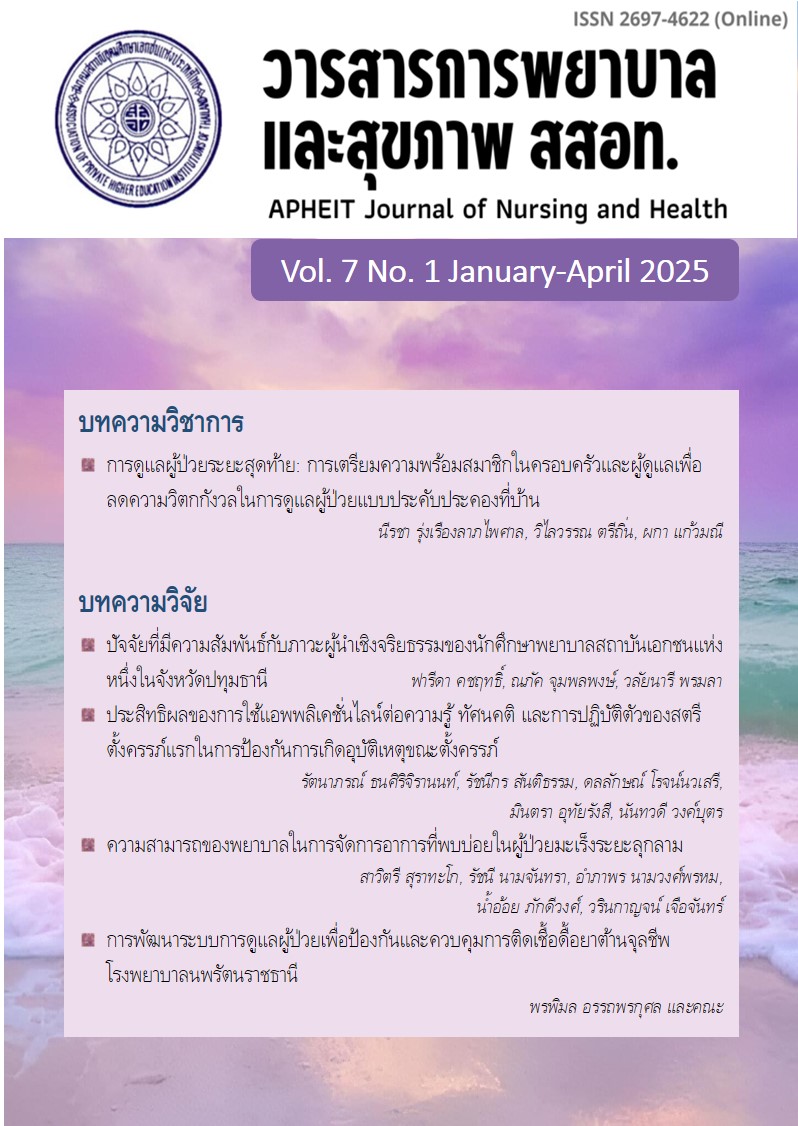Hospice Care Preparing Family Members and Caregivers to Reduce Anxiety in Home Palliative Care
Main Article Content
Abstract
Caring for a loved one at the end of life can be an emotionally intense experience, and sometimes the situation may become overwhelmingly difficult to bear. Confronting the complexities and facing the reality of impending loss often leads to distress and anxiety among family members and caregivers. Nevertheless, it reflects profound love, goodwill, and gratitude toward the person who is respected and cherished. This article focuses on alleviating the anxiety experienced by family members and caregivers by preparing them to understand palliative care for terminally ill patients—helping them grasp the philosophy and approach of palliative care, not as a withdrawal of treatment, but as a means of preserving human dignity, alleviating pain and discomfort, and enhancing the patient’s quality of life as much as possible during the final stage of life. Ultimately, the goal is to ensure that death occurs naturally and that the patient passes away peacefully and with warmth.
Article Details

This work is licensed under a Creative Commons Attribution-NonCommercial-NoDerivatives 4.0 International License.
เนื้อหาและข้อมูลในบทความที่ลงตีพิมพ์ในวารสารการพยาบาลและสุขภาพ สสอท. ถือเป็นข้อคิดเห็นและความรับผิดชอบของผู้เขียนบทความโดยตรง ซึ่งกองบรรณาธิการวารสารไม่จำเป็นต้องเห็นด้วย หรือร่วมรับผิดชอบใดๆ
บทความ ข้อมูล เนื้อหา รูปภาพ ฯลฯ ที่ได้รับการตีพิมพ์ในวารสารการพยาบาลและสุขภาพ สสอท. ถือเป็นลิขสิทธิ์ของวารสารการพยาบาลและสุขภาพ สสอท. หากบุคคลหรือหน่วยงานใดต้องการนำทั้งหมด หรือส่วนหนึ่งส่วนใดไปเผยแพร่ หรือเพื่อกระทำการใดๆ จะต้องได้รับอนุญาตเป็นลายลักษณ์อักษรจากวารสารการพยาบาลและสุขภาพ สสอท. ก่อนเท่านั้น
References
กรมการแพทย์ กระทรวงสาธารณสุข. (2563). คู่มือการดูแลผู้ป่วยแบบประคับประคองและระยะท้าย (สำหรับบุคลากรทางการแพทย์). สืบค้น 16 มิถุนายน 2567, จาก https://www.dms.go.th/backend//Content/Content_File/Practice_guidelines/Attach/25640114130713PM_aw%20คู่มือการดูแลผู้ป่วยแบบประคับประคอง_5.pdf
คณะแพทยศาสตร์ โรงพยาบาลรามาธิบดี มหาวิทยาลัยมหิดล. (ม.ป.ป.). การดูแลแบบประคับประคอง หรือ Palliative Care. สืบค้น 4 พฤษภาคม 2568, จาก https://www.rama.mahidol.ac.th/cancer_center/th/palliative-care
ฉันชาย สิทธิพันธุ์. (2563). การดูแลผู้ป่วยระยะสุดท้าย. ใน หมอชวนรู้ แพทย์สภา. สืบค้น 30 มิถุนายน 2567, จากhttps://tmc.or.th/pdf/tmc_knowlege-59.pdf
พรทวี ยอดมงคล. (2556). คู่มือสำหรับประชาชน การดูแลผู้ป่วยระยะสุดท้ายแบบประคับประคอง (Palliative Care). สืบค้น 20 มิถุนายน 2567, จาก https://www.rama.mahidol.ac.th/palliative/sites/default/files/public/Pallative%20care.pdf
เพ็ญจุรี วีระธนาบุตร. (ม.ป.ป.). ผู้ป่วยระยะสุดท้าย คือใครบ้าง?. สืบค้น 4 พฤษภาคม 2568, จาก https://peacefuldeath.co/ผู้ป่วยระยะสุดท้าย/
ศูนย์การุณรักษ์. (2557). รายงานสรุปโครงการการจัดการความรู้เพื่อหา Key success ของการจัดบริการศูนย์ดูแลผู้ป่วยระยะท้ายในระดับโรงพยาบาลศูนย์/โรงพยาบาลทั่วไป. ขอนแก่น: ศูนย์การุณรักษ์.
สำนักงานคณะกรรมการสุขภาพแห่งชาติ [สช.]. (2556). การดูแลผู้ป่วยระยะสุดท้ายแบบประคับประคอง (Palliative Care). สืบค้น 16 มิถุนายน 2567,จาก https://www.rama.mahidol.ac.th/palliative/sites/default/files/public/Pallative%20care.pdf
สำนักงานสถิติแห่งชาติ. (2565). การสำรวจประชากรสูงอายุในประเทศไทย พ.ศ. 2564. สืบค้น 16 มิถุนายน 2567, จาก https://www.dop.go.th/download/knowledge/th1687612748-2406_0.pdf
อรวิธู กาญจนจารี, ยุพาพิน ศิรโพธิ์งาม, และสุปรีดา มั่นคง. (2560). บทบาทและความต้องการของผู้ดูแลผู้ป่วยระยะท้ายในสถานบริการที่มีการดูแลแบบประคับประคองโดยเฉพาะ. รามาธิบดีพยาบาลสาร, 23(3), 328-343.
World Health Organization [WHO]. (2020). Palliative care. Retrieved July 3, 2024, from https://www.who.int/news-room/fact-sheets/detail/palliative-care
